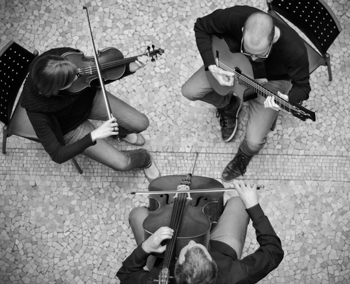by Mike Telin

The ensemble designed the evening to emulate an art installation: performing in the middle of the space, they encouraged the audience to move around and experience how the sound changed from place to place. Paper and pencils were provided for those who wanted to write, sketch, or doodle, which proved to be enticing for many of the adults as well as young audience members.
Alessandro Stradella’s Sinfonia in d, No. 22 kicked off the evening. Producing a well-blended, healthy sound, the trio — playing on period instruments — stylishly moved between the work’s many tempo changes.
Returning to the room with modern instruments, the ensemble began Free Improvisation for Three Voices with a simple statement from the guitar. Fasani Stauffer, Gjernes, and Stauffer passed this idea from one to another, each adding a new twist to the motif. The tempo slowly accelerated during a catchy guitar solo with playful slides in the cello. That forward movement suddenly blossomed into a full-bodied melodic section with all three players producing long, lush lines.
Impressively, the group improvisation had a structure, and was not merely a ‘I’ll play, now you play’ course of events.
Serbian-American composer and classical guitarist Dušan Bogdanović’s Quatre piéces intimes (1997) for cello and guitar is an engaging blend of classical, jazz, and folk music. The opening “Priére” features a lyrical cello line over simple guitar chords. “Mouvement” is marked by fast-paced syncopated rhythms, while “La Harpe de David” is a beautiful lament. The concluding “Chant” includes a guitar ostinato under a long, melodic cello line. The performance was first-rate. Roland Gjernes and Joshua Stauffer were a dynamic duo, performing with robust, centered sounds, spot-on intonation, and unwavering rhythm, while never forgetting to make music.
Period instruments reemerged for a dazzling interpretation of Giovanni Antonio Pandolfi Mealli’s Violin Sonata, Op. 3, No. 4, “La Castella.” Dating from 1660, the work is made up of a series of virtuosic violin passages over a bass line. Fasani Stauffer’s sound sparkled as she tossed off its long phrases with flair. The Sonata’s galloping ending was exciting to hear.
Philipp Friedrich Böddecker’s Sonata in d from 1651 also comprises a series of short, contrasting episodes of violin pyrotechnics over a figured bass. Again, Fasani Stauffer was in her element as she easily transitioned from one mood to the next. The cadenza-like section was particularly splendid, and the coordination between the solo line and the continuo department was ideal.
The ensemble moved into the 21st century for the world premiere of Jeremy Allen’s arresting Time and Pressure (2017). After long, soft chords in the violin and cello, the guitar enters, adding a pulse to the music which slowly builds in volume. A meditative section features leading tones in the cello that stylishly emphasize the twists and turns of the work’s harmonic structure. Rhythms are slowly introduced and build until the piece comes to a sudden stop. The music continues with guitar chords below a lyrical violin line which melds into a quasi-folk song in the violin. Time and Pressure ends as it began, with extended chords over a guitar ostinato. The players brought out the piece’s compelling narrative arc in an engrossing performance.
Astor Piazzolla’s alluring Oblivion, in an arrangement by Julien Labro, was the perfect ending to a most enjoyable evening. Time Canvas is a musically commanding ensemble that is a welcome addition to Cleveland’s chamber music scene.
Published on ClevelandClassical.com November 22, 2017.
Click here for a printable copy of this article



